How to make a two-chamber septic tank from concrete rings: a building instruction
Issues of waste disposal in suburban areas concern both summer residents and owners of private houses. Most summer cottages and many small settlements in the country are not provided with the ability to connect to centralized networks. It's hard to come to terms with this situation, isn't it?
A two-chamber septic tank made of concrete rings will allow getting rid of problems, for the construction of which a minimum of funds and effort will be required. To build such a system without any problems you can do it yourself. However, even if it is planned to attract workers, it is absolutely necessary to know the rules and features of the device. After all, the construction must work without fail.
We offer to get acquainted with reliable information about the construction of concrete septic tanks, the basics of designing an autonomous treatment plant and its organization. In addition to valuable information, we picked up photos, diagrams and video guides.
The content of the article:
Dual chamber design
A septic tank consisting of two chambers is a practical sewage treatment plant capable of processing organic waste.
The cleaning mechanism is based on the work of two communicating compartments, inside of which the separation of the liquid component and the insoluble solid component occurs by sedimentation.
Each compartment of a two-chamber structure is responsible for certain tasks:
- First camera. It receives drains from the inlet sewer coming from the house. Inside the chamber, the sewage settles, as a result of which solid fractions sink to the bottom, and clarified waste flows through an overflow pipe into the second compartment. The sludge accumulating at the bottom must be periodically pumped out.
- The second camera. Responsible for the final disposal of clarified sludge. Passing through a soil filter with a capacity of 1 m, the effluents are treated to an extent that allows them to freely enter the environment without the threat of disturbing the natural balance.
Additional cleaning inside the second chamber is achieved by a gravel or gravel filter. It prevents the penetration of insoluble inclusions into soil strata.
The clarified drains that have undergone this treatment significantly reduce the total volume of sewer mass, so that it is possible to call down the sewers much less frequently to empty autonomous sewer objects.

Often instead filtration wells place filter fields. They represent several parallel trenches, the bottom of which is covered with gravel and sand dumping.
Pipes with perforated walls are laid on top of the filter bed. The whole structure is covered with rubble and sand and sprinkled with soil.
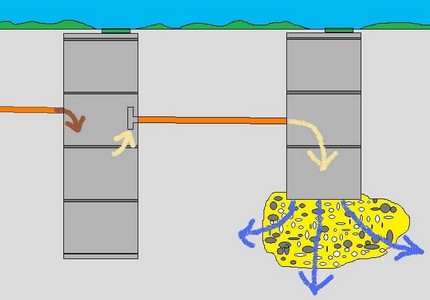
The use of concrete rings: the pros and cons
The main thing that "bribe" septic tanks made of concrete rings - affordable cost with high operational parameters. After all, reinforced concrete is rightfully considered one of the most durable materials.
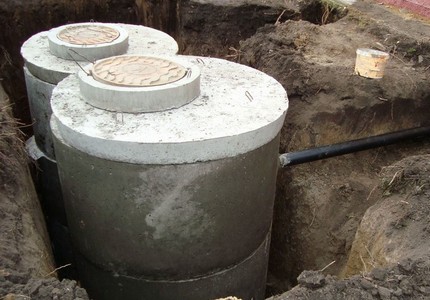
Among the indisputable advantages of concrete septic tanks, consisting of two compartments, it is worth highlighting:
- Resistance to soil movementsharp volley discharges of sewage and the aggressive effects of the sewer.
- Ability to recycle cubic meters of effluent. In the process of multi-stage cleaning, the bulk of the effluent is discharged in the form of clarified liquid outside the structure.Only a small part of the sludge settles at the bottom, formed as a result of processing the organic component by bacteria, always present in the sewer masses.
- Easy operation and maintenance. It is only necessary to involve scavengers to clean the walls of a capacious structure from accumulations only every two to three years.
- Long service life. The operational period of concrete rings can reach more than half a century, and with proper care - even longer.
Wastewater treatment plants made of concrete rings will not “float” to the surface under the influence of frost heaving of soils, as this often happens with lightweight tanks.
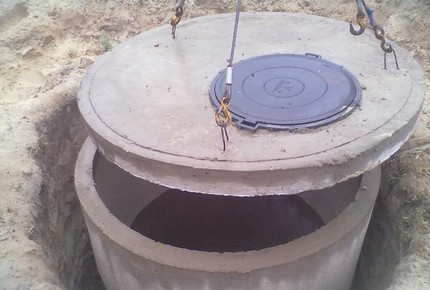
But this design has its drawbacks:
- The need to attract construction equipment for installation. It is almost impossible to deliver heavy rings to the place and load them into the pit without the use of construction equipment.
- Allocation for the arrangement of a large territory, which is not always possible in areas of small area.
Tanks made of concrete rings may lose their integrity during operation. The cause of depressurization of the structure may be the appearance of cracks and leakage at the joints of the elements.
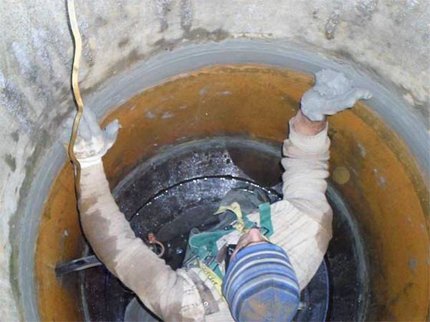
Among the "minuses" of the construction, some users highlight the fact that even with proper installation in the septic tank, an unpleasant odor emanates from the contents.
But this defect is easily eliminated by using biological products, which contain bacteria that process organics. They easily fix the problem, but at the same time they do not damage the concrete surface and the sewer pipe.
Tank volume calculation
One of the key conditions for the smooth operation of a sewage treatment plant is a competent calculation of its volume.
To correctly calculate the volume of a septic tank, you need to focus on three parameters:
- The number of people who live in the house constantly.
- The total daily volume of sewage waste per person.
- The time interval during which organic substances have time to completely recycle.
In the calculation, they take as a basis that the average daily amount of effluents per household is 200 liters. And on average, it takes up to three days to process organic substances inside the treatment plant.
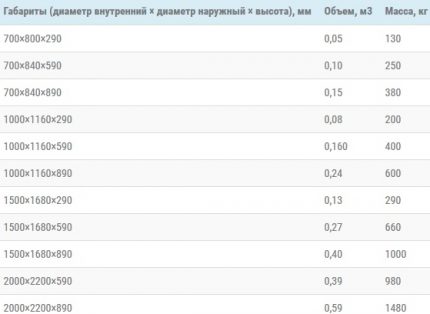
Knowing that one person per day accounts for an average of 200-250 liters of water consumed, it is easy to calculate that the three-day amount of waste per household will be about 600 liters. The resulting value can only be multiplied by the number of family members permanently living in the house.
When calculating, it is also worth taking an additional margin of 15-20%. It will help to avoid overfilling in the event of a temporary increase in the number of household members and a stay in the guest house for several days.
So for a family of four, a building with a capacity of 200 l x 3 days is required. x 4 people = 2.4 cc m. We round off the value and get that for a family of 4 people you need a septic tank with a capacity of 2.5-3 liters.
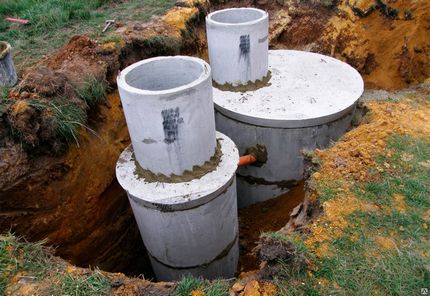
If the location of the mini-treatment plant has a high level of groundwater occurrence, which can provoke a slowdown in the water removal process and even flooding of the structure, consider installing a septic tank that drains sewage to drainage fields.
Choosing a place for a sewage treatment plant
When designing a treatment plant, a sanitary zone is placed away from significant objects on the site so that organic waste does not accidentally fall into the source of drinking water.
When choosing a place for placement of a building, they are guided by two standards: SNiP 2.-4.03.85 and SanPiN 2.2.1 / 2.1.1200-03.They spelled out the rules for building external sewer structures and lists the requirements for the arrangement of zones that may pose an environmental hazard to the environment.
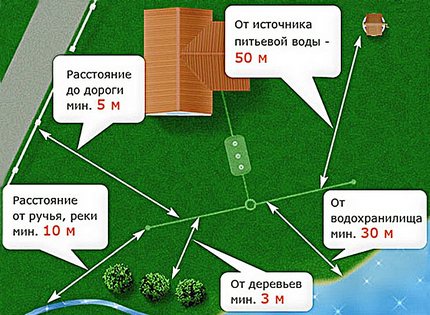
If there are nearby water bodies with running water, the distance to them should be maintained at least 20 m. If there are plantings on the site, then the distance to the trees should be about 3 m, and to shrubs - no more than 1 m.
When planning the arrangement of the sanitary zone, it is worthwhile to clarify the location of the underground gas pipe in order to maintain a distance of 5 m to it.
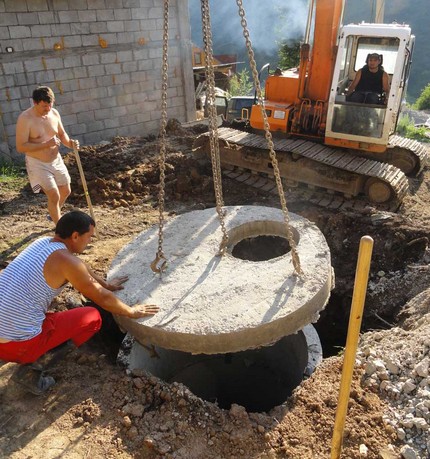
It is important to provide free space for access and maneuvering construction and sewage equipment. At the same time, keep in mind that it is impossible to place it directly above the septic tank deepening site, since a heavy machine can destroy the walls of the treatment plant.
Septic tank mounting technology
When installing a two-chamber septic tank made of concrete rings, be prepared for the fact that this is a rather difficult and painstaking work. To facilitate your task, use the services of special equipment or attract two or three assistants to perform the work.
Raising a heavyweight ring, even for a few workers, will be problematic. Well, installing it exactly in place is even more difficult.
Purchase of materials and components
Concrete rings are available in various sizes on the market. The height of the products is always the same and is 90 cm, but the diameter can vary from 70 to 200 cm.
The volume of the ring depends on its diameter. So, the reinforced concrete ring with a cross section of 70 cm has a volume of 0.35 cubic meters. m. And the construction of tanks with a volume of 2.5 cubic meters will require 7-8 of these rings.
If you use rings with a size of 100 cm, each of which has a volume of 0.7 cubic meters. m, the construction of tanks of the same capacity will require only 4 of these rings.

The price of a product depends on its size. Therefore, in order not to miscalculate, beforebuying rings always calculate the total volume and the required amount.
When calculating the capacity of a treatment plant and choosing rings for its construction, consider that the actual volume of the tank should be higher than the calculated one. This is because the liquid as it fills will not be able to rise above the level of overflow openings, which are placed 20-25 cm below the upper edge of the column.
When choosing rings of the required diameter, it is necessary to take into account the level of groundwater. The higher the groundwater, the larger the ring size. Indeed, as the diameter increases, their number decreases, and, consequently, the installation depth of the entire treatment plant decreases.
Of the materials also required:
- pipes D110-120 mm;
- tees for overflows;
- crushed stone of three different fractions;
- river sand.
The soil filter in the second chamber is formed of three layers of gravel or crushed stone, the size of the fraction of each underlying layer should be less than the fraction of the previous one.
In addition, you will need to stock up with liquid glass, cement for preparing the solution on the site and mounting foam for sealing the joints.
Tools required for work:
- bayonet and shovel;
- building level;
- hammer drill;
- stairs;
- a bucket with a rope;
- container for kneading;
- narrow spatula;
- wide brush.
For laying sewage to a septic tank and creating overflows, it is permissible to use different types of pipes. Often equip a polypropylene or asbestos-cement pipeline.
Technology septic tank construction from concrete rings includes a number of standard steps:
Earthworks
The best time to start excavation is in the hottest weather or the time after the first frost, when the groundwater level has the lowest rates.
For the arrangement of a two-chamber cleaner, it is better to dig a common foundation pit for two wells at once. Although some experts are of the opinion that it is better to create two independent pits for each tank of the structure.
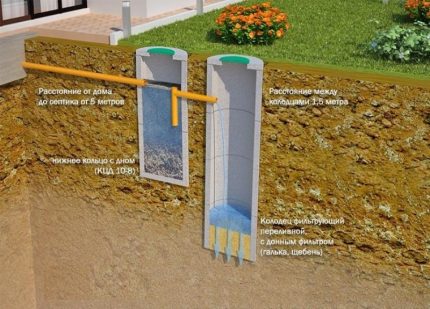
The dimensions of the pit are determined by the diameter of the selected rings.
When calculating the dimensions of the pit, the following points should be considered:
- Pit depth should be 30-40 cm lower than the height of the rings used. This is necessary in order to equip the filling at the bottom or pour concrete screed.
- Pit Length and Width should be such that the distance from the walls of the pit to the rings is at least 50-70 cm. This is necessary in order to simplify installation and to be able to waterproof the outer walls of the structure.
You can also dig a pit manually with a shovel, removing soil with a bucket. But it’s much easier to use special equipment for this, with the help of which it will not be difficult to dig a hole in just a few hours.
In conditions of limited space, it is most convenient to use a small excavator. It is better to immediately remove the soil extracted from the pit outside the site, using the same machine for this purpose as it brought the rings.
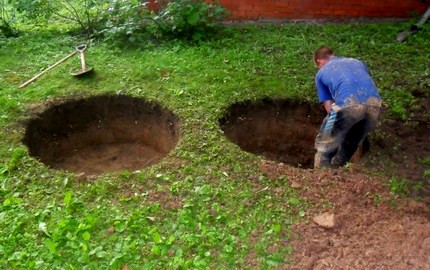
When creating a common pit for two tanks, the result should be a two-level pit so that the first compartment is half a meter deeper than the first.
At the same stage trenches for sewer pipes. They are laid below the freezing level of soil layers, which for regions of middle latitudes is about 1.2-1.5 m.

The bottom of the trenches is aligned, guided by the construction level, and rammed. The leveled base is covered with a layer of crushed stone or sand, on top of which subsequently the supply pipes are laid.
Pouring the foundation and erecting walls
The bottom of a dug pit is carefully leveled and tamped. The leveled base is covered with a sand layer, forming a “pillow” with a thickness of 15-20 cm. The formed bed is well tamped, creating a smooth and devoid of surface.
To create a concrete base under the storage tank, the bottom of the pit is poured with cement mortar.
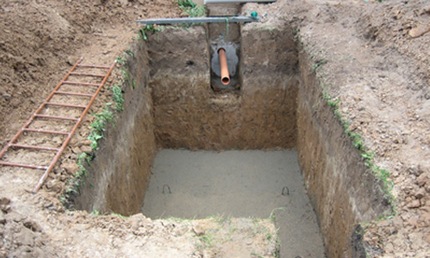
The size of the concrete screed should be 20-30 cm larger than the diameter of the rings used. Depending on temperature and weather conditions, it can take four or more weeks to harden the cement mortar. Only then do they begin to install the first ring.
To pass the stage of pouring the concrete base and facilitate your work, it is better to use ready-made bottoms of sewer wells. They, like rings, are produced by precast concrete plants.
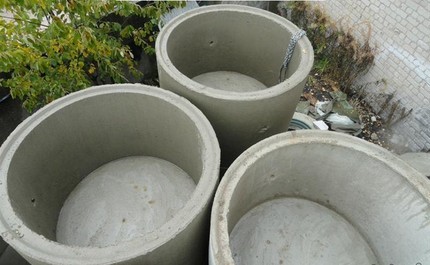
Using a crane, the first ring is mounted so that its walls are placed strictly vertically. This is necessary in order to ensure the stability and strength of the structure. From above, a second one is erected on it. Etc.
To strengthen the fixation strength at the joining points, metal brackets are mounted on the outside of the rings. The entry points are covered with a layer of concrete and sealed.
Waterproofing Measures
To reduce the impact of groundwater on concrete, while protecting the structure from leaking, all joints between the bottom and walls from the inside should be sealed with cement mortar. Both the inner and outer walls of the tank are subject to processing.
To improve the water resistance of the composition and to accelerate its solidification, water glass is added to the solution. The main thing is to maintain a ratio of 25% when water glass is added to cement.
When this indicator is exceeded, the adhesive can degrade the properties of the cement, increasing the risk of solidification of the mortar directly in the kneading tank.
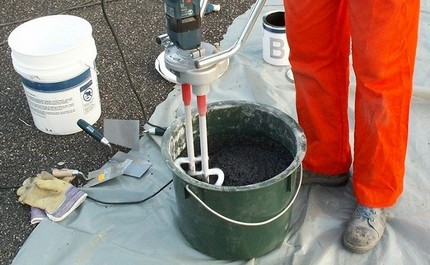
To improve the waterproof properties of the construction, the craftsmen recommend using 2-3 types of waterproofing materials.
To process the walls of concrete elements, apply:
- deep penetration impregnation;
- bituminous waterproofing mastic.
The only condition is not to use toxic compounds that can destroy the beneficial bacteria of the sump. For insulation from the outside, the surface is covered with bitumen mastic or rolled material with a similar composition of derivatives.
An alternative and fairly reliable option is septic plastic insert from the rings.
At the top of the well, a concrete cover with a hole is installed, inside of which a cast-iron hatch with a removable cover is mounted. To prevent freezing of the system, the upper part of the tanks is insulated with polystyrene foam cuts.
Features of creating a filtration compartment
The second well of the structure is constructed in the same way. The only difference is the creation of a filter layer. It is laid at the bottom and along the walls of the tank.
For this, the bottom of a dug pit is covered with:
- the first layer of sand - a thickness of 10-15 cm;
- the second layer of fine-grained gravel is 15-20 cm thick.
When forming a bed, it is necessary to compact it carefully.To do this, the tamper of the "pillow" is alternated with filling it with water.
If it is assumed lateral unloading of treated effluents, the walls of the absorption well are made of special perforated rings, the size of the holes of which is 30-50 cm.
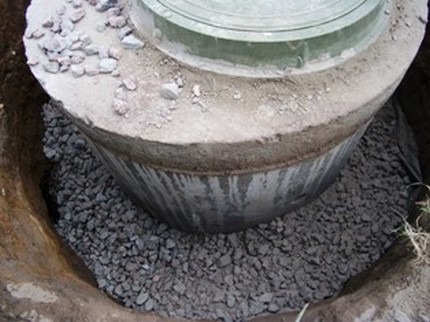
In the upper part of the tank, a neck with holes for a sewer hatch and a ventilation riser is installed. The vent tube should be 70-80 cm above the ground.
For the installation of an overflow pipe between the tanks, a trench is dug. The overflow is constructed so that the height difference between the entrance to the first compartment and the exit to the second tank is 15-20 cm.
The inlet and overflow pipes between the chambers must be equipped with tees.
The easiest way to make a hole in the tank wall for overflow is with a perforator. Having brought the edge of the pipe into the wall of the drive, fix it by blowing foam. Frozen foam will perform a dual function: to act as a damper pad and retain moisture.
After making sure of the tightness of the structure, proceed to its backfill. To do this, the voids between the outer surface of the well and the pit are covered with earth previously mixed with sand. To create additional waterproofing, clay is used when backfilling.
Conclusions and useful video on the topic
An overview of one of the options for a two-chamber septic tank:
Secrets of proper installation:
How to build a septic tank at minimal cost:
In general, the installation of a two-chamber septic tank made of concrete rings, albeit a troublesome, but quite feasible task.
The main thing is to responsibly approach the choice of a place for its arrangement and strictly adhere to the installation technology. And then, the sewage treatment plant will serve for more than a dozen years, making suburban life more comfortable.
Have experience building a septic tank from concrete rings? Please share information with our readers, tell us about the features of the arrangement and operation of autonomous sewage. You can leave comments in the form below.

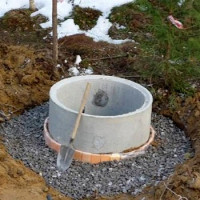 How to make a septic tank out of rings with your own hands: schemes and options + step-by-step instructions
How to make a septic tank out of rings with your own hands: schemes and options + step-by-step instructions 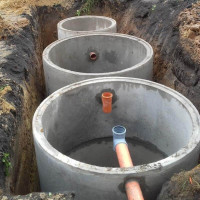 Septic tank made of concrete rings: device, schemes + step-by-step installation process
Septic tank made of concrete rings: device, schemes + step-by-step installation process 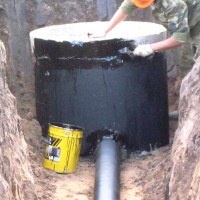 Waterproofing a septic tank made of concrete rings: a review of materials + rules for implementation
Waterproofing a septic tank made of concrete rings: a review of materials + rules for implementation 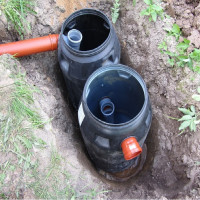 How to make a septic tank with your own hands from barrels using plastic containers as an example
How to make a septic tank with your own hands from barrels using plastic containers as an example 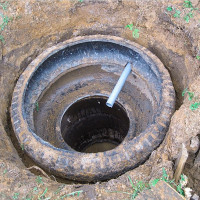 How to arrange a septic tank from tires with your own hands: step-by-step instructions
How to arrange a septic tank from tires with your own hands: step-by-step instructions 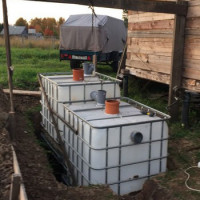 How to make a septic tank from European cubes with your own hands: step-by-step assembly instructions
How to make a septic tank from European cubes with your own hands: step-by-step assembly instructions  How much does it cost to connect gas to a private house: the price of organizing gas supply
How much does it cost to connect gas to a private house: the price of organizing gas supply  The best washing machines with dryer: model rating and customer tips
The best washing machines with dryer: model rating and customer tips  What is the color temperature of light and the nuances of choosing the temperature of the lamps to suit your needs
What is the color temperature of light and the nuances of choosing the temperature of the lamps to suit your needs  Replacement of a geyser in an apartment: replacement paperwork + basic norms and requirements
Replacement of a geyser in an apartment: replacement paperwork + basic norms and requirements
According to your scheme, no wastewater treatment takes place in the second chamber, and over time, harmful substances will accumulate around the chamber, which will poison everything around the filtration perimeter from the second well. Indeed, the so-called “clarified effluents” contain a lot of harmful organic and inorganic substances. And no filtration fields will remove these substances from drains! This option is suitable for those who save on the environment.
An interesting option for organizing a sewage treatment plant, but it is not new. Many articles about this method. After all, autonomous systems with bioremediation are quite expensive, in addition to maintaining them in perfect working condition, you need to constantly live in a house that serves a volatile septic tank. Not everyone can afford this option. The main thing in determining what you need is to take into account not only your convenience, but the specifics of the area.